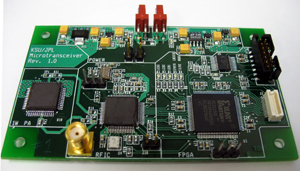Sources: Bill Kuhn, 785-532-4649, wkuhn@k-state.edu;
and Tim Sobering, 785-532-7826, edl@k-state.edu
Photo available. Contact media@k-state.edu or 785-532-6415
News release prepared by: Erinn Barcomb-Peterson, 785-532-6415, ebarcomb@k-state.edu
Wednesday, June 10, 2009
NASA HONORS K-STATE ENGINEERING RESEARCHERS FOR THEIR WORK ON A MICRO TRANSCEIVER FOR USE ON FUTURE MARS ROVERS AND SCOUTS
MANHATTAN -- NASA is recognizing Kansas State University engineers and their colleagues for developing wireless technology aimed at the search for water -- and ultimately life -- on Mars.
The Mars Proximity Micro Transceiver team received NASA's Group Achievement Award for "outstanding innovation in the design and prototyping of a highly miniaturized, in situ, communications transceiver for use in future NASA missions."
 The award is recognizes outstanding accomplishment through the coordination of many individual efforts that contribute substantially to the NASA mission. It was presented June 9 at NASA's Jet Propulsion Laboratory at the California Institute of Technology in Pasadena, Calif.
The award is recognizes outstanding accomplishment through the coordination of many individual efforts that contribute substantially to the NASA mission. It was presented June 9 at NASA's Jet Propulsion Laboratory at the California Institute of Technology in Pasadena, Calif.
Partnering with the Jet Propulsion Laboratory and Peregrine Semiconductor, K-State engineers developed a small, lightweight micro transceiver to transmit scientific data from vehicles on Mars back to earth. Leading the K-State effort were Bill Kuhn, professor of electrical and computer engineering, and his students. The development was supported by K-State's Electronics Design Laboratory, a multidisciplinary research lab directed by Tim Sobering.
When the project began, NASA's current transceivers were about 3 inches tall, 7 inches wide and 5 inches long. They weighed in at 4.5 pounds and used as much as 70 watts of power. The micro transceiver is about 30 times smaller in volume, 100 times lighter and up to 10 times more energy efficient.
Kuhn said that one benefit of a smaller transceiver is that it allows for smaller vehicles, which means sending multiple vehicles in one launch. And these vehicles, he said, are currently the only way to search for evidence of past or current water on Mars. Knowing precisely where water is or may have been, Kuhn said, is necessary before more elaborate human exploration missions are organized to look for evidence of life on the planet.
The project was completed in 2007 and may be applied to future scout missions to the planet, or possibly to the Earth's moon in the coming decade. More information is available at the project's Web site at http://www.ece.ksu.edu/research/mars
More information about the Electronics Design Lab is at http://www.k-state.edu/ksuedl/